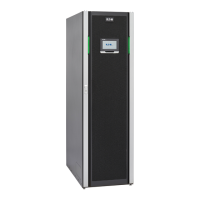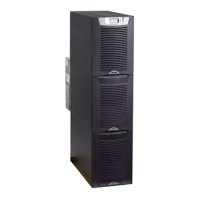5 Eaton® 9390 (100–160 kVA) UPS Installation and Operation Manual 164201604—Rev F
11..33 BBaassiicc SSyysstteemm CCoonnffiigguurraattiioonnss
The following basic UPS system configurations are possible:
• Single module UPS and one to four battery cabinets
• Single module UPS with UPS Sidecar (maintenance bypass or 1+1 tie configuration) and one to four
battery cabinets
• Single module UPS, one to four battery cabinets, and an optional IDC
• Single module UPS, one to four battery cabinets, and an optional IAC (maintenance bypass, 1+1 tie, or 1+1
tie with maintenance bypass configuration)
• Single module UPS, one to four battery cabinets, and an optional IAC (distribution configuration)
• Eaton Hot Sync parallel system with two UPS modules, one to four battery cabinets for each UPS, and an
optional module tie cabinet
– One capacity/one redundant (1+1)
– Two capacity (2+0)
• Eaton Hot Sync parallel system with three UPS modules, one to four battery cabinets for each UPS, and an
optional module tie cabinet
– Two capacity/one redundant (2+1)
– Three capacity (3+0)
• Eaton Hot Sync parallel system with four UPS modules, one to four battery cabinets for each UPS, and an
optional module tie cabinet
– Three capacity/one redundant (3+1)
– Four capacity (4+0)
• Eaton Hot Sync parallel system with two UPS modules, one to four battery cabinets for each UPS, an
optional module tie cabinet, and an optional IDC
– One capacity/one redundant (1+1)
– Two capacity (2+0)
• Eaton Hot Sync parallel system with three UPS modules, one to four battery cabinets for each UPS, an
optional module tie cabinet, and an optional IDC
– Two capacity/one redundant (2+1)
– Three capacity (3+0)
• Eaton Hot Sync parallel system with four UPS modules, one to four battery cabinets for each UPS, an
optional module tie cabinet, and an optional IDC
– Three capacity/one redundant (3+1)
– Four capacity (4+0)
The UPS system configuration can be enhanced by adding optional accessories such as a Remote Emergency
Power-off (REPO) control, RMP II, or X-Slot communication cards.
Introduction

